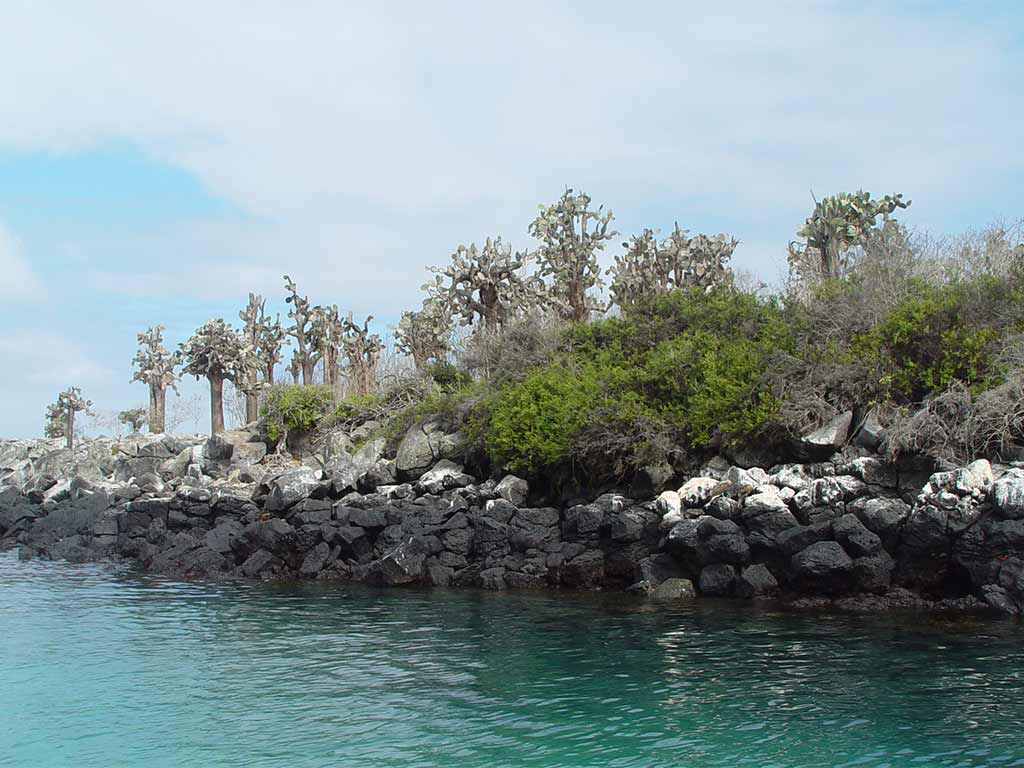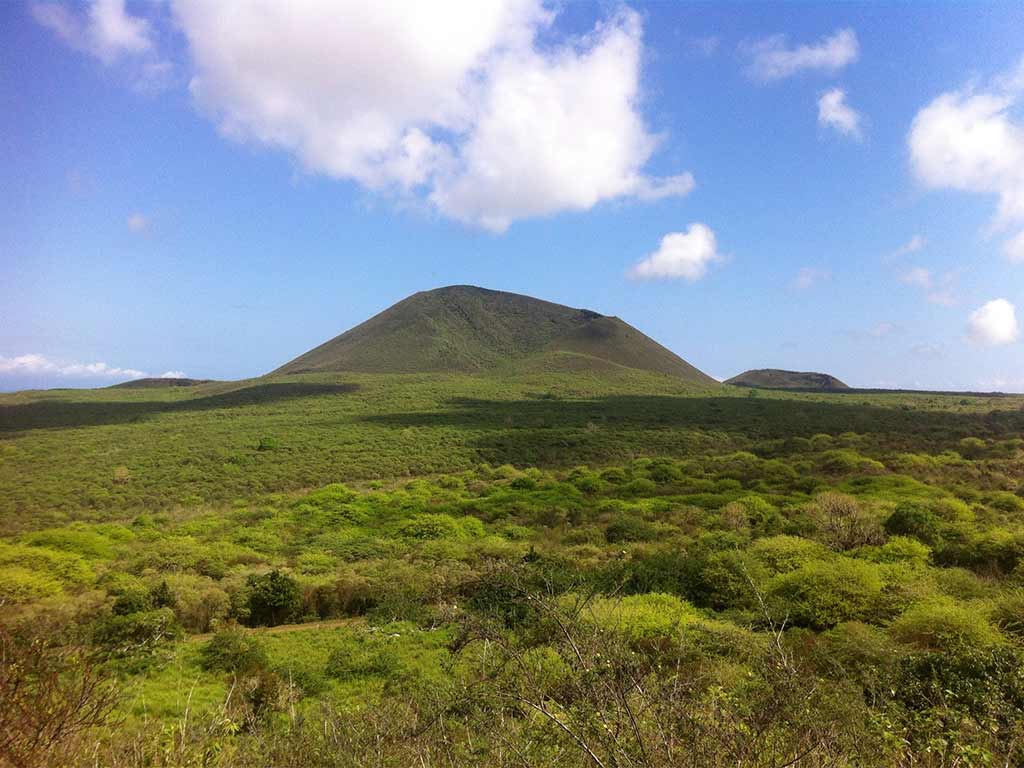Photography

Up Close and Personal with the New Tortoises on Santa Fe
September 10, 2015
By guest author Tui De Roy.
Not often in Galapagos do I use my full stalking skills: hiding behind bushes and cacti, moving slowly upwind, stepping gingerly to avoid any thump of my footfall. I find myself holding my breath too, though unnecessarily, and nearly burst out laughing. What am I stalking? A tortoise...who would have thought! And a baby tortoise at that, no bigger than a football, but destined to become a giant.
But then, this is no ordinary giant tortoise, but a very, very special one indeed: a true founder, along with 200 others, set free six weeks ago to repopulate Santa Fe Island, where tortoises were exterminated some one and a half centuries ago. OK, so this isn't the original species, which is extinct, but a very close kin — both in shape and ancestry — from Española Island though bred in captivity, and this little fellow looks to be right at home.
For a moment I manage to stay hidden, watching enthralled at what he's doing. He (I fancy this is a male, but there's no visible difference in babies) has just come out of his little bed-scrape under a bush and is looking for breakfast. The rains here ended two months ago, but he still finds plenty to satisfy his appetite: a little clover-like green leaf here, a small yellow legume flower there. And, oh there: a freshly fallen cactus pad, irresistible to tortoises of all sizes. He strides purposefully over, ducking to unsnag pesky vines catching on the front edge of his shell.
At 10 years of age he is just beginning to show the raised front edge of his carapace that will eventually turn him into a great Saddleback Tortoise, the type found only on really dry islands like this one. He circles the pad, trying to find the best angle of attack, then opens his little mouth wide and tears off his first juicy chunk, spines and all. Anxious for a photo, I slowly poke my lens out from behind the thick cactus trunk I'm using to hide... and my cover is blown!
His head rises like a periscope, eyes bright, throat pumping to assess my scent. His next move is predictable: rotate turret; engage gears; dash for the nearest thick bush. What kind of behavior is that, instead of just pulling in his head and acting like a boulder, as tortoises do on other islands? Only the saddlebacks from Española exhibit this check-it-out-and-run behavior. Is that what saved the last 14 individuals on their native island from being eaten by whalers? Did the sailors just find it too hard to extricate them from the wicked thorn bushes under which they'd crammed themselves at the first sign of trouble?
This little fellow is not taking any chances. His little four-inch legs propel him through the dry grass faster than I can reposition for a photo, reminding me of a scuttling hedgehog. Admittedly, the first things he ever saw in life were big human hands lifting him out of the tortoise incubator at the Galapagos National Park’s Tortoise Center on Santa Cruz Island and plunking him onto the scales.
This routine was repeated countless times as he slowly grew, together with his brethren in his pen, along with regular measurements, occasional blood sampling, and the injection of a tiny computerized PIT tag under the skin of his hind leg. In fact, Wacho Tapia, director of the Giant Tortoise Restoration Initiative, and the park rangers are not far behind me to perform another set of checks, except this time the weighing will involve dangling dizzyingly from a string hooked onto a hand scale. And just to make sure he doesn't get away, he also has a radio transmitter and antenna Epoxied to the side of his shell.
When he arrives, Wacho is amazed: this tortoise, like all the others he's checked, has been growing in leaps and bounds since his release. In just six weeks he's already over three kilos (6.6 pounds), while none had reached this milestone before release.
On day four I meet an even more "special" tortoise, 'Estrellita' or 'Starlet' for lack of a better name, Number One of the platoon, the very first of the new Santa Fe tortoise dynasty. This time I fancy Estrellita to be a female, and she too makes a beeline for the densest thicket after eying me suspiciously. She only stops when she feels well hidden — indeed if I didn't know she was there, I'd never spot her. Just then a mockingbird hops down and starts tugging at her radio antenna, as if to say "You're home now, you don't need these modern contraptions anymore." Home she is, but Wacho and his team will be looking after her for many more for years to come.
I remember when I was a child exploring Santa Fe I came across a smooth polished rock with a hollow in the middle where drizzle obviously gathered into a puddle. I was mystified, wondering what had worn down this one rock to such a gloss, until years later I discovered on another island that this is the work of thousands of generations of thirsty tortoises. It gives me goose-bumps to think that one day soon, little elephantine tortoise feet will once again slip and slide over this shiny wet rock on misty days.
Tui De Roy is a world-renowned, award-winning wildlife photographer and writer. A self-taught naturalist, she has spent most of her life in the Galapagos Islands. Among her many books, she has published seven large-format books on Galapagos. She is currently working with the Galapagos National Park Directorate to help them document their work through photography.

Galapagos and Beyond: April 2015 Roundup
April 30, 2015
This month's roundup features an article on Floreana Island and plans for tortoise restoration, an update on the ban on plastic bags in Galapagos, new research on the invasive Philornis downsi fly, insight into managing the Galapagos pet population, and some fun penguin info for World Penguin Day. Enjoy!
Floreana Island: Intrigue, Tradition, and Restoration
"Here at Post Office Bay on Floreana Island, visitors are in charge of delivering the mail. And there’s no Facebook, texting or tweeting allowed." These words are from travel writer Simon Willis, who recently traveled to Galapagos and recounted his experience visiting Floreana on Travelmag. Willis also interviewed GC's Science Advisor Dr. Linda Cayot on restoration efforts for the Floreana giant tortoise, which include an upcoming expedition to Wolf Volcano on Isabela Island, in collaboration with the Galapagos National Park Directorate, to collect hybrid tortoises with Floreana ancestry. Of all the Galapagos Islands, Floreana has experienced the greatest environmental degradation. Read more about this unique island and plans to restore the giant tortoise population.
Galapagos Phasing Out Plastic Bags by 2017
Galapagos officials are in the process of phasing out plastic shopping bags and other plastic items in the Islands, with a goal to eliminate them entirely by 2017. Last December, the Galapagos National Park Directorate began delivering cloth bags to residents of the archipelago with support from Celebrity Xpedition’s Galapagos Fund, and people are increasingly putting them to use in the local markets. Plastics contribute to the deaths of countless seabirds, turtles, fish, and other marine animals worldwide each year, making the ban in Galapagos an important step (and example) for marine conservation efforts.
Invasive Parasitic Fly May Be from Mainland Ecuador
The parasitic fly Philornis downsi, a native of mainland South America, was accidentally introduced to the Galapagos Islands in the 1990s — with dire consequences for mangrove finches and other endemic species of land birds. Philornis larvae feed on the blood of nestlings, and can cause up to 95% mortality. While it is uncertain exactly how the fly arrived in the Islands, scientists have hypothesized that they came from mainland Ecuador, even though they had never been found there. New research reported in the Annals of the Entomological Society of America supports this hypothesis, as scientists have documented the parasitic fly at two sites near Ecuador’s coast. Researchers continue to study the fly in order to identify control and eradication methods.
Managing the Galapagos Pet Population
Many local residents of Galapagos own domestic pets like dogs and cats and, as is true elsewhere in the world, pet overpopulation has become a serious problem — particularly for endemic Galapagos wildlife, which may succumb to predation. This makes managing the pet population in Galapagos critical, through efforts to limit their population size and provide them with quality veterinary care to prevent disease. Darwin Animal Doctors, a non-profit organization providing free veterinary care in the Islands, is doing exactly that. Founder Tod Emko and Board Chair Andrea Gordon recently discussed some of the achievements they made in the past year through sterilization, education, and more in this month's guest blog post. This important work offers a humane approach to managing the Galapagos pet population while simultaneously protecting native wildlife.
Celebrating World Penguin Day 2015
April 25, 2015 marked World Penguin Day, a day dedicated to celebrating all the remarkable penguin species of the world. We're partial to the Galapagos penguin (of course), which is the rarest and most endangered of all penguin species, and our favorite online resource is provided by penguin expert Dr. Dee Boersma of the University of Washington: igalapagos.org. Dr. Boersma is using photographs taken by Galapagos tourists and other visitors, which they can submit directly to her website, to inform research and conservation efforts for the penguins. The iGalapagos website provides comprehensive information on where to find penguins in Galapagos, what specifically to photograph, the biology of penguins, and more. In the spirit of World Penguin Day 2015, we would also like to share a stunning penguin slideshow compiled by the BBC featuring 15 marvelous penguin photos. Enjoy.

Comments